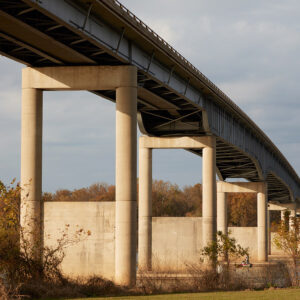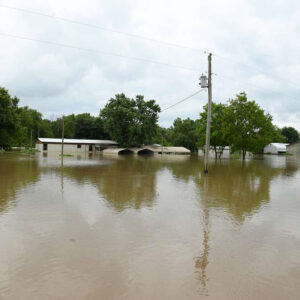calsfoundation@cals.org
Pendleton (Desha County)
Pendleton (Desha County) is the site of the only highway bridge over the Arkansas River between Pine Bluff (Jefferson County) and the Mississippi River forty miles downriver from the bridge. Pendleton is located in the northwestern-most part of Desha County. It was also the site of a major levee break on April 16, 1927, during the Flood of 1927.
The Pendleton Post Office was open from 1867 to 1926 in one of the two general stores at the “town” of Pendleton. When much labor was required to farm the fertile land, a large community thrived in the area. The community was named for Dr. Samuel H. Pendleton, who was born in Amherst, Virginia. He moved his family to the area in 1858. Prior to the Civil War, roadbed for the Little Rock and Napoleon Railroad was under construction when Pendleton established his plantation on the south side of the Arkansas River in the general area where the current bridge is located. The proposed railroad promised to make the land along the route even more valuable. At the time, a number of wealthy land speculators resided temporarily in the area. Other large communities developing near the river along the proposed rail route near Pendleton were Douglass (Lincoln County), Auburn (Lincoln County), South Bend (Lincoln County), Varner (Lincoln County), and Medford (Desha County), while a few miles down the river Red Fork (Desha County) flourished.
Civil War and Reconstruction stopped construction on the railroad bed until after July 1869, when rights were sold to the Little Rock, Pine Bluff and New Orleans Railroad, later consolidating with the Mississippi, Ouachita and Red River Railroad, which operated under the name Texas, Mississippi River and Northwestern Railroad. Construction resumed, but the planned route was not to Napoleon (Desha County) but to Eunice (Chicot County), a more suitable site, south of present-day Arkansas City (Desha County). The route still passed through the Pendleton community, but on March 15, 1879, Congress passed an act to allow the train track to be relocated beginning at Varner and proceed due south, instead of southeast through Pendleton. The area around Pendleton had not relied heavily on the railroad because it existed such a short time, and most travel was still by steamboat. The only remaining evidence of the train through Pendleton is a coveted fishing spot near the bridge called “coal pile,” where the train once refueled.
Being located along the river, Pendleton was hard hit by the Flood of 1927. One survivor, Mildred Cross Smith, later related that a skiff picked her family up to take them to a steamboat as the waters from the flood threatened their home. The levee soon broke at Pendleton. The steamboat took the family to Rosedale, Mississippi, where they took a train to Memphis, Tennessee. Water now covers the place where Smith’s home once stood.
The Pendleton area was once the site of the Desha County Prison Farm. Farmers needing cheap labor could hire prisoners for a dollar a day. Cheap labor was in demand to clear the land for lumber and till the farmland once the trees were removed. The prison farm was closed around 1945. The once-thriving community of Back Gate (Desha County) five miles south of the bridge was so named because the back gate of the Desha County Prison Farm was located there, while the front gate of the prison was located where the ferryboat at Pendleton operated at the time.
A U.S. Army Corps of Engineers Park and Campground is located two miles from the bridge, and nearby is Wilbur D. Mills Dam, the second dam of the McClellan-Kerr Arkansas River Navigation System; the dam was completed in 1968. Also nearby in Arkansas County are the Norrell Lock and Dam, which was completed in 1967 as the first lock and dam on the river.
The Pendleton Bridge over the Arkansas River was opened in 1971, eighty-one years after the U.S. Congress approved the bridge on April 10, 1890. Before the bridge was finally constructed, traffic between Arkansas and Desha counties relied on a ferryboat. State Highway 1 and U.S. Highway 165 span the bridge. A restaurant and small motel are located at the Pendleton Bridge.
Instead of land that once consisted of swamps and giant trees and occasionally received Arkansas River flood waters, the rich soil is now tilled by farmers growing primarily soybeans, rice, corn, and wheat. Some farms still grow a limited amount of cotton. One of the few remaining cotton gins in Desha County is located in nearby Back Gate. Riceland Foods has a port loading grain at their large grain elevator on the Arkansas River at Pendleton.
Pendleton was one of many Arkansas locations affected by the Flood of 2019.
For additional information:
Biographical and Historical Memoirs of Southeast Arkansas. Chicago: Goodspeed Publishing Company, 1890.
Images from the Past: A Pictorial History of Desha County, Arkansas and Southeast Arkansas Delta. Marceline, MO: Heritage House, 1992.
Programs of the Desha County Historical Society. McGehee: Desha County Historical Society (1974–).
Helen Pennington
Pine Bluff, Arkansas
 Coal Pile Lake
Coal Pile Lake  Desha County Map
Desha County Map  Pendleton Bridge
Pendleton Bridge  Pendleton Flood
Pendleton Flood 




Mrs. Mildred Cross Smith was born at Pendleton in 1919. She was living in Little Rock and was interviewed in January 2011. She was eight years old during the 1927 Flood. Her home, typical of plantation homes of the time, was set on high pillars with a large porch along the front facing the river. Underneath the house was another level that had once been slave quarters. Her grandfather Dr. James Goree lived a half mile up the river in a house identical to hers. The house had a landing for people to step onto from their wagons before climbing the steps to keep their feet from getting in the mud. A skiff picked up her family to take them to a steamboat as the 1927 Flood threatened. Her father, who was a friend of the steamboat captain, stayed behind to do what he could. Victoria Cross, her mother, wasnt worried at first but cried when she heard the news that the levee broke at Pendleton. The steamboat took them to Rosedale, Mississippi, where they took a train to Memphis. Water now covers the place where her home once stood. Her family lived in Pine Bluff a few years until her father could build them a house near Lennox Lake.